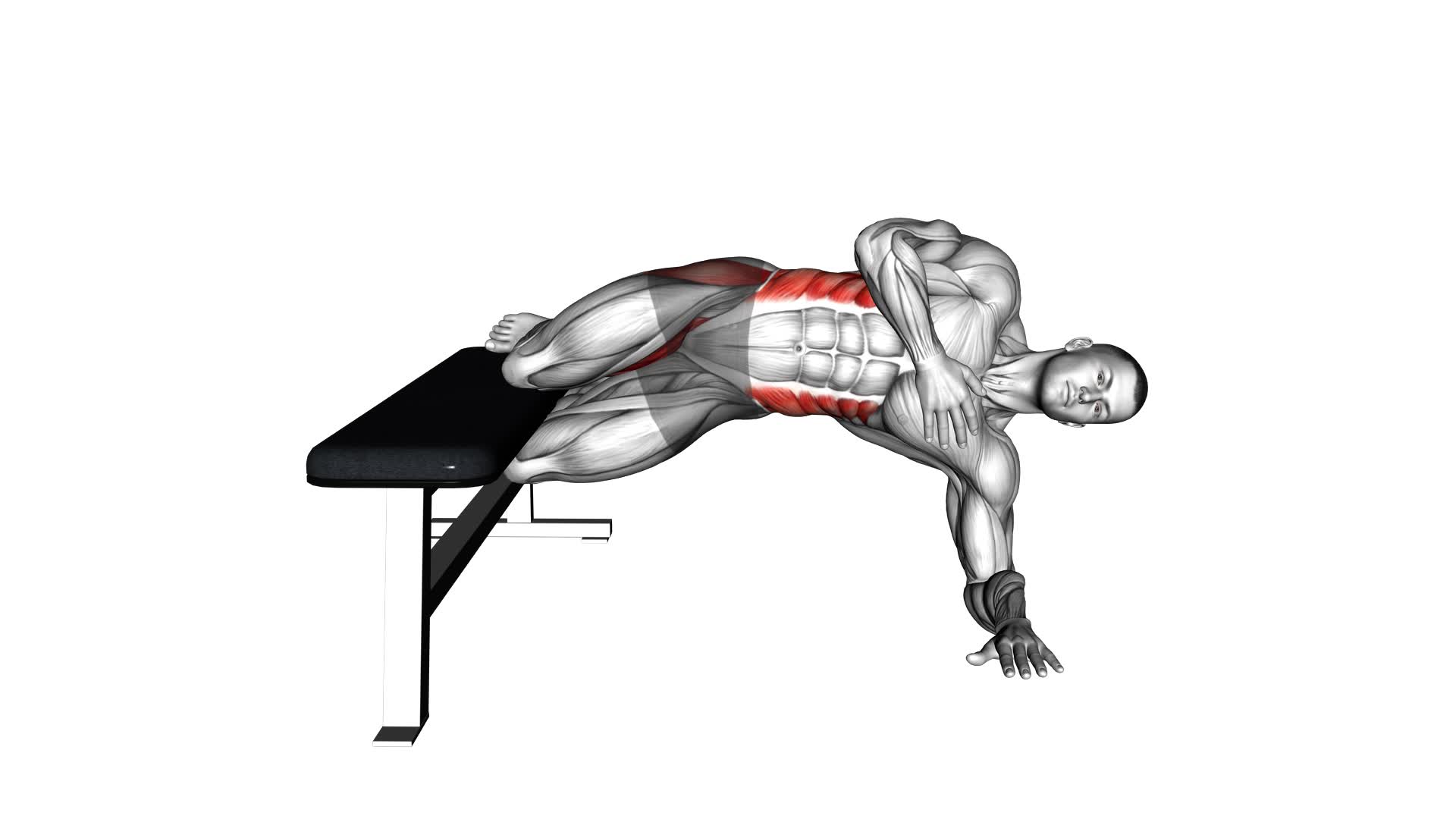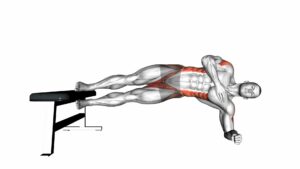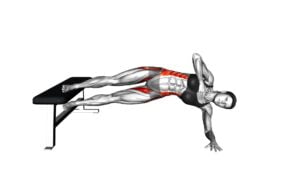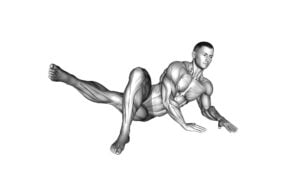Side Plank Hip Adduction (Bent Knee) – Video Exercise Guide & Tips

Are you looking to strengthen your core and hips? Then side plank hip adduction is the exercise for you!
Watch This Exercise Video
In this video exercise guide, we'll show you the proper form and technique to perform this move effectively. You'll also learn about the benefits, common mistakes to avoid, and modifications to make it more challenging.
So, grab a mat and get ready to feel the burn with side plank hip adduction!
Key Takeaways
- Side plank hip adduction targets the obliques and glutes, strengthening the lower back and improving stability.
- Proper form and technique, along with proper breathing, enhance core engagement and help avoid injuries.
- Equipment such as an exercise mat, ankle weights, and resistance bands can be used to modify and increase the intensity of the exercise.
- Beginners can start with modifications like bending the bottom knee or resting it on the ground, and gradually progress to straightening the bottom leg and lifting it off the ground.
Benefits of Side Plank Hip Adduction
The side plank hip adduction exercise offers numerous benefits for your core and hip muscles. This exercise not only targets your obliques and glutes but also helps to strengthen your lower back and improve overall stability.
Proper breathing techniques play a crucial role in maximizing the benefits of the side plank hip adduction exercise. As you lift your hips off the ground and bring your top leg towards your chest, exhale through your mouth. This helps engage your core muscles and stabilize your body throughout the movement. Inhale through your nose as you lower your leg back down and return to the starting position.
It is important to be cautious and take preventive measures to avoid injuries while performing the side plank hip adduction. Make sure to maintain proper form throughout the exercise by keeping your body in a straight line and avoiding sagging or arching your back. Also, listen to your body and start with lighter resistance or modifications if needed. Gradually increase the difficulty as your strength and stability improve.
Equipment Needed for Side Plank Hip Adduction
To perform the side plank hip adduction exercise, you'll need minimal equipment. Here are the equipment options and alternative exercises you can consider:
- Equipment options:
- Exercise mat: A mat will provide cushioning and support for your body during the exercise.
- Ankle weights: If you want to increase the intensity of the exercise, you can use ankle weights to add resistance and challenge your muscles further.
- Alternative exercises:
- Side plank with leg lift: If you don't have ankle weights, you can perform a side plank with leg lift instead. This exercise targets the same muscles and helps improve hip stability.
- Side lying clamshell: This exercise focuses on the hip abductor muscles, just like the side plank hip adduction. Lie on your side with your knees bent and feet together. Lift your top knee while keeping your feet together, then slowly lower it back down.
Proper Form and Technique for Side Plank Hip Adduction
To perform the Side Plank Hip Adduction with proper form and technique, it's essential to engage your core muscles effectively. This exercise primarily targets the obliques and hip adductors, helping to improve stability and strength in the core and hips.
Engaging Core Muscles Effectively
To effectively engage your core muscles during Side Plank Hip Adduction, focus on maintaining proper form and technique. Here are some tips to help you engage your core effectively:
- Start by positioning yourself in a side plank position, with your elbow directly under your shoulder and your legs extended.
- Engage your core by pulling your belly button in towards your spine, creating a strong and stable base.
- Keep your hips lifted and your body in a straight line from head to toe.
Slowly bring your top leg forward, crossing it in front of your bottom leg, and then lift it back up to the starting position.
- As you perform the hip adduction movement, focus on engaging your obliques and deep core muscles.
- Remember to breathe throughout the exercise to maintain proper oxygen flow to your muscles.
Benefits of Side Plank
Engage your core effectively during Side Plank Hip Adduction by maintaining proper form and technique.
Side plank is a challenging exercise that offers numerous benefits for your body. One of the main advantages is that it targets your obliques, strengthening and toning these muscles along the sides of your abdomen. Additionally, side plank helps improve stability and balance, as you have to engage your core to hold the position. It also works your glutes, shoulders, and hips, making it a great full-body exercise.
Furthermore, side plank can be modified to suit different fitness levels. You can start with a bent knee position and gradually progress to a straight leg variation. These modifications allow you to gradually build strength and stability.
Transitioning now to the next section, let's explore the common mistakes to avoid during side plank hip adduction.
Common Mistakes to Avoid During Side Plank Hip Adduction
One common mistake to avoid during side plank hip adduction is neglecting to maintain proper alignment of your body. Proper technique is crucial for maximizing the effectiveness of this exercise and minimizing the risk of injury.
Here are some common mistakes to watch out for:
- Allowing your hips to sag: It's important to keep your body in a straight line from head to toe. Avoid letting your hips drop towards the ground, as this can put excessive strain on your lower back and diminish the benefits of the exercise.
- Flaring your ribs: Keep your core engaged by drawing your belly button towards your spine. Avoid allowing your ribs to pop out or your lower back to arch excessively.
Remember, the goal of side plank hip adduction is to strengthen your core, hips, and glutes. By maintaining proper alignment and technique, you can target these muscles effectively and avoid unnecessary strain or discomfort.
Focus on engaging your core, keeping your body in a straight line, and breathing deeply throughout the exercise.
Modifications and Progressions for Side Plank Hip Adduction
Make modifications and progressions for side plank hip adduction to challenge your stability and build strength in your core, hips, and glutes.
If you find the side plank hip adduction too challenging, you can modify the exercise by bending your bottom knee and resting it on the ground. This will provide additional support and make it easier to maintain proper form.
As you become more comfortable with the exercise, you can gradually increase the difficulty by straightening your bottom leg and lifting it off the ground. This will require more strength and stability in your core and hips.
Additionally, you can progress the exercise by adding a resistance band around your thighs. The band will provide additional resistance, making the exercise more challenging and helping to further strengthen your hip adductors.
Remember to always listen to your body and only progress to the next level when you feel ready. By making modifications and progressions to the side plank hip adduction, you can continually challenge yourself and make progress in your strength and stability.
Tips for Incorporating Side Plank Hip Adduction Into Your Workout Routine
To effectively incorporate side plank hip adduction into your workout routine, it's important to focus on proper form techniques. Make sure you maintain a straight line from your head to your toes, engaging your core and glutes throughout the exercise.
For beginners, it can be helpful to start with variations that involve bending the knee or using a stability ball for support.
Proper Form Techniques
To properly incorporate side plank hip adduction into your workout routine, it's important to focus on maintaining a strong and stable core throughout the exercise. Here are some proper form techniques to help you engage your core muscles effectively:
- Begin by assuming a side plank position with your forearm on the ground and your body in a straight line.
- Bend your bottom knee and place your foot on the ground for added stability.
- Keep your hips lifted and engage your core by pulling your belly button towards your spine.
- Slowly lift your top leg while keeping your hips stable and your core engaged.
- Lower your leg back down with control and repeat on the other side.
By following these proper form techniques, you can ensure that you're engaging your core muscles effectively during the side plank hip adduction exercise.
Now, let's move on to discussing variations for beginners.
Variations for Beginners
To incorporate side plank hip adduction into your workout routine as a beginner, you can start with a modified version of the exercise. One beginner modification is to perform the exercise with your bottom knee bent and resting on the ground for added stability. This will help you build strength in your core and hips before progressing to the full exercise.
When attempting the side plank hip adduction, beginners often make some common mistakes. One mistake is allowing your hips to sag or lift too high, which can put strain on your lower back. To avoid this, focus on maintaining a straight line from your head to your heels throughout the exercise.
Another mistake is forgetting to engage your core and glutes. By actively squeezing your core and glutes, you'll increase the effectiveness of the exercise and protect your lower back.
Incorporating these beginner modifications and avoiding common mistakes will help you properly execute the side plank hip adduction and progress safely in your fitness journey.
Frequently Asked Questions
How Many Sets and Reps Should I Do for Side Plank Hip Adduction?
To progress in side plank hip adduction exercises, it's important to determine the number of sets and reps. Start by doing 2 sets of 10 reps on each side, focusing on maintaining proper form throughout.
As you become more comfortable and stronger, gradually increase the number of sets and reps.
Avoid common mistakes such as sagging hips or rushing through the movement.
Remember to listen to your body and adjust accordingly to avoid injury.
Can Side Plank Hip Adduction Help With Lower Back Pain?
Side plank hip adduction is a great exercise for strengthening your core and can potentially help with lower back pain. By engaging your core muscles and stabilizing your body, this exercise can improve the overall strength and stability of your lower back.
To perform it correctly, make sure to maintain proper form and technique. Focus on keeping your body in a straight line and avoid letting your hips sag. Remember to contract your glutes and engage your core throughout the exercise.
Is Side Plank Hip Adduction Suitable for Beginners?
Side plank hip adduction is a great exercise for beginners. It helps strengthen your core muscles and improve stability.
By adding the bent knee variation, you can target your hip muscles even more. This exercise also benefits your lower back by promoting proper alignment and reducing strain.
If you're new to side planks, start with the basic variation and gradually progress to hip adduction. Remember to maintain proper form and listen to your body to avoid injury.
How Long Should I Hold the Side Plank Position Before Starting the Hip Adduction Movement?
Before starting the hip adduction movement in the side plank position, it's important to hold the side plank for an adequate amount of time. This will help you develop stability and strength in your core and hips.
While the exact duration may vary based on your fitness level and goals, aim to hold the side plank for at least 30 seconds before beginning the hip adduction movement.
This variation of the side plank offers numerous benefits, including improved hip strength, stability, and balance.
Can Side Plank Hip Adduction Help Improve Balance and Stability?
Side plank hip adduction variations can definitely improve your balance and stability. By engaging your core muscles and targeting the hip adductors, this exercise helps to strengthen your core and improve overall stability.
The side plank position challenges your balance, while the hip adduction movement adds an extra challenge for your core muscles.
Incorporating side plank hip adduction into your workout routine can lead to better balance, stability, and core strength.
Conclusion
Incorporating side plank hip adduction into your workout routine can provide numerous benefits, such as strengthening your core and improving hip stability.
By following proper form and technique, and avoiding common mistakes, you can maximize the effectiveness of this exercise.
Additionally, modifications and progressions can be made to suit your fitness level.
With the right equipment and guidance, side plank hip adduction can be a valuable addition to your fitness regimen.

Author
Years ago, the spark of my life’s passion ignited in my mind the moment I stepped into the local gym for the first time. The inaugural bead of perspiration, the initial endeavor, the very first surge of endorphins, and a sense of pride that washed over me post-workout marked the beginning of my deep-seated interest in strength sports, fitness, and sports nutrition. This very curiosity blossomed rapidly into a profound fascination, propelling me to earn a Master’s degree in Physical Education from the Academy of Physical Education in Krakow, followed by a Sports Manager diploma from the Jagiellonian University. My journey of growth led me to gain more specialized qualifications, such as being a certified personal trainer with a focus on sports dietetics, a lifeguard, and an instructor for wellness and corrective gymnastics. Theoretical knowledge paired seamlessly with practical experience, reinforcing my belief that the transformation of individuals under my guidance was also a reflection of my personal growth. This belief holds true even today. Each day, I strive to push the boundaries and explore new realms. These realms gently elevate me to greater heights. The unique combination of passion for my field and the continuous quest for growth fuels my drive to break new ground.







